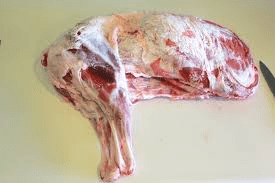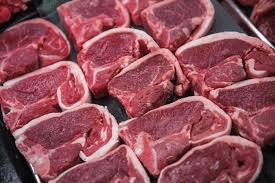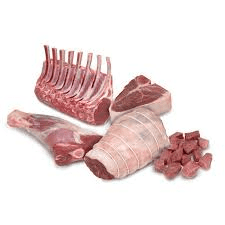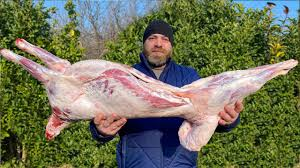Processing, packaging, and exporting sheep meat involves several important steps to ensure that the meat is safe, high-quality, and ready for international markets. The process starts with raising and caring for sheep. Proper nutrition, health care, and living conditions are essential for producing healthy sheep and high-quality meat. Once the sheep reach the appropriate age and weight, they are prepared for processing.
The first step in processing sheep meat is slaughtering. The sheep are humanely slaughtered following strict hygiene and animal welfare standards. The process begins with stunning, which renders the sheep unconscious to minimize suffering. After stunning, the sheep are bled by cutting the major blood vessels to ensure that the blood is fully drained from the carcass. This step is crucial for maintaining meat quality and preventing spoilage.
After bleeding, the next step is skinning. The skin is removed carefully to avoid damaging the meat. Once the skin is removed, the sheep carcass is eviscerated, which involves removing the internal organs like the heart, liver, and intestines. This process must be done carefully to prevent contamination of the meat. The carcass is then thoroughly washed to remove any residual blood and internal debris.
Once cleaned, the sheep carcass is chilled to lower its temperature quickly. Chilling is done to prevent bacterial growth and spoilage. This can be achieved by immersing the carcass in ice-cold water or using air-chilling methods. After chilling, the carcass is inspected by veterinarians and quality control experts to ensure it meets health and safety standards.
Following inspection, the carcass is cut into various parts according to market demand. These parts typically include legs, shoulders, ribs, and chops. The cuts are trimmed to remove excess fat and bone, ensuring that only high-quality meat is prepared for sale. Some cuts may be further processed into ground meat or sausages, depending on customer preferences.
Packaging is a crucial step to maintain the quality of sheep meat during transportation. The meat is packaged in airtight materials to prevent exposure to air and moisture, which can cause spoilage. Fresh sheep meat is often vacuum-sealed or placed in modified atmosphere packaging. Frozen sheep meat is packed in sturdy, freezer-safe containers or bags to keep it frozen. Proper labeling is also important, providing information such as the type of cut, weight, expiration date, and handling instructions.
Exporting sheep meat involves complying with various international regulations and standards to ensure that the meat is safe and meets the requirements of the importing country. Exporters must obtain necessary certifications, such as health certificates, which confirm that the meat has been inspected and meets safety standards. The meat must also be accompanied by documentation such as certificates of origin, which verify where the sheep were raised and processed.
Transportation is a key component of exporting sheep meat. The meat must be handled carefully to prevent damage and contamination. For fresh sheep meat, maintaining a cold chain is essential, meaning the meat must be kept at a consistent, low temperature throughout transit. Refrigerated containers are commonly used to ensure this. For frozen sheep meat, it is important to keep the meat at the appropriate frozen temperature during transport. Monitoring temperature and ensuring proper handling are crucial for maintaining meat quality.
Upon arrival in the destination country, the sheep meat undergoes customs clearance, where the documentation and quality of the meat are checked. If everything is in order, the meat is cleared for entry into the market and is then distributed to retailers, wholesalers, or directly to consumers.
Processing, packaging, and exporting sheep meat involves several detailed steps to ensure that the meat is high-quality and safe for consumers. From humane slaughtering and careful processing to effective packaging and adherence to export regulations, each step is crucial in delivering a product that meets global standards. By following best practices throughout the entire process, producers and exporters can provide sheep meat that satisfies international customers and complies with regulatory requirements.
How to Process Sheep Meat for Exportation

1. Preparation: Ensure your workspace is clean and well-organized. Gather all necessary tools, including knives, saws, and sanitizers. This step is vital to maintaining hygiene and preventing contamination.
2. Selecting the Sheep: Choose healthy sheep for processing. They should be free from diseases and fit for consumption. Verify their health and ensure they meet the required export standards.
3. Slaughtering: Use humane slaughtering practices. Make sure the sheep is properly stunned before slaughter to minimize suffering. Follow local and international animal welfare regulations.
4. Skinning: Carefully remove the sheep’s hide using sharp knives. Avoid tearing the skin to maintain the quality of the meat. Proper skinning is crucial for ensuring the meat remains in good condition.
5. Evisceration: Remove internal organs and entrails. This step is essential to prevent contamination and spoilage. Ensure all organs are completely removed and disposed of properly.
6. Carcass Cleaning: Rinse the carcass with clean, cold water. This helps remove any blood and debris, ensuring a clean surface for further processing.
7. Cutting: Divide the carcass into desired cuts, such as legs, shoulders, and loins. Use sharp, sanitized knives to make clean cuts and avoid cross-contamination.
8. Cooling: Chill the meat immediately after cutting to slow bacterial growth. Use a cold storage room or refrigeration to maintain the meat at the appropriate temperature.
9. Inspection: Have the meat inspected by a qualified professional to ensure it meets health and safety standards. This step is critical for compliance with export regulations.
10. Packaging: Package the meat in sanitary, tamper-proof materials. Proper packaging is necessary to preserve the meat’s quality and safety during transport.
Read Also: Rose Chafer: Description, Damages Caused, Control and Preventive Measures
How to Package Sheep Meat for Exportation

1. Choose Packaging Materials: Use high-quality, food-grade materials like vacuum-sealed bags or plastic wrap. These materials help maintain freshness and prevent contamination.
2. Labeling: Label each package with essential information, including product name, weight, and expiration date. Proper labeling is crucial for compliance with international export regulations.
3. Portioning: Divide the meat into appropriate portions based on customer requirements or export standards. This facilitates efficient handling and distribution.
4. Vacuum Sealing: Seal the meat in vacuum bags to remove air and prevent freezer burn. Vacuum sealing also helps extend the meat’s shelf life and maintains its quality.
5. Freezing: Freeze the packaged meat to maintain its freshness during transport. Ensure the freezing process is rapid to preserve texture and flavor.
6. Inspection: Check each package for leaks, tears, or defects. Properly sealed packages are essential for preventing spoilage and ensuring product integrity.
7. Storage: Store the packaged meat in a cold storage facility until it is ready for shipment. Maintain a consistent temperature to prevent thawing and spoilage.
8. Compliance: Ensure the packaging meets the export country’s regulations, including any specific requirements for labeling or material types.
9. Documentation: Prepare all necessary export documentation, such as certificates of origin and health certificates. Proper documentation is required for customs clearance.
10. Transport Preparation: Arrange for appropriate transportation methods that maintain the required temperatures. Use insulated containers or refrigerated transport to keep the meat frozen until it reaches its destination.
How to Export Sheep Meat for Profits
1. Market Research: Conduct research to identify potential markets, demand, and pricing. Understand the preferences and regulations of target countries to effectively position your product.
2. Regulatory Compliance: Familiarize yourself with export regulations, including health and safety standards. Ensure compliance with both local and international requirements to avoid legal issues.
3. Certifications: Obtain necessary certifications, such as sanitary and phytosanitary certificates, to verify the quality and safety of your meat. These certifications are crucial for gaining trust in international markets.
4. Pricing Strategy: Develop a competitive pricing strategy based on market research and production costs. Consider factors such as shipping, tariffs, and other expenses when setting prices.
5. Find Buyers: Connect with potential buyers or distributors in target markets. Use trade shows, online platforms, and industry contacts to establish business relationships.
6. Negotiate Terms: Agree on terms of sale, including payment methods, delivery schedules, and contract terms. Clear agreements help avoid misunderstandings and ensure smooth transactions.
7. Logistics Planning: Plan the logistics of shipping, including selecting reliable transport providers and managing shipping documents. Efficient logistics are essential for timely delivery and maintaining product quality.
8. Quality Control: Implement strict quality control measures throughout processing, packaging, and shipping. High-quality products are more likely to attract repeat customers and positive reviews.
9. Marketing and Promotion: Develop marketing strategies to promote your sheep meat. Utilize online marketing, trade promotions, and local partnerships to build brand awareness and attract buyers.
10. Monitor and Adapt: Continuously monitor market trends and customer feedback. Be prepared to adjust your strategies based on market changes and customer preferences to maximize profitability.
Read Also: 12 Medicinal Health Benefits Of Ilex guayusa (Guayusa)
Frequently Asked Questions (FAQs) About Sheep Meat

1. What is sheep meat?
Sheep meat, also known as lamb or mutton depending on the age of the sheep, is the meat from sheep. Lamb is from younger sheep, while mutton is from older sheep. It is known for its rich flavor and tender texture.
2. How is sheep meat different from other meats?
Sheep meat is generally more flavorful and tender than beef or pork, with a unique taste that can vary depending on the sheep’s age. Lamb is milder and more tender compared to mutton.
3. How should sheep meat be stored?
Sheep meat should be stored in a freezer if not used immediately. Proper packaging and freezing are essential to maintain freshness and prevent spoilage.
4. What are common cuts of sheep meat?
Common cuts include the leg, shoulder, ribs, and loin. Each cut can be used for various cooking methods, such as roasting, grilling, or stewing.
5. How do you cook sheep meat?
Sheep meat can be cooked in many ways, including roasting, grilling, braising, and stewing. Cooking times vary based on the cut and desired tenderness.
6. Is sheep meat healthy?
Yes, sheep meat is considered healthy, especially lamb, which is leaner and has less fat than mutton. It is high in protein and contains essential nutrients like iron and zinc.
7. Can sheep meat be exported?
Yes, sheep meat can be exported. However, it must meet specific health and safety standards and regulations set by both the exporting and importing countries.
8. What are the benefits of eating sheep meat?
Sheep meat is rich in protein and essential nutrients, making it a nutritious choice. It also provides important vitamins and minerals, such as iron and vitamin B12.
9. How can I ensure quality when buying sheep meat?
To ensure quality, buy sheep meat from reputable sources, check for freshness, and look for proper labeling. The meat should be bright red, firm, and free from any unpleasant odors.
10. What are some popular dishes made with sheep meat?
Popular dishes include lamb curry, roasted lamb, shepherd’s pie, and grilled lamb chops. Sheep meat is used in various cuisines and recipes for its rich flavor and versatility.
Read Also: How To Raise Chickens – The Simple Secrets To A Great Backyard Flock

